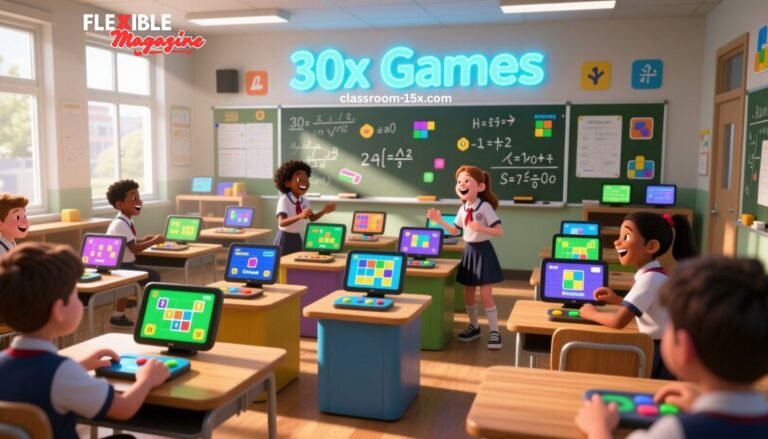Education is evolving faster than ever before. From traditional chalkboards to interactive smartboards, from heavy textbooks to e-learning platforms, classrooms are no longer what they used to be. One of the newest concepts transforming education is Classroom 30x, a forward-looking model that integrates technology, personalized learning, and collaborative environments to prepare students for the challenges of the modern world.
In this comprehensive article, we will explore what Classroom 30x really means, how it is changing the learning experience, its advantages and challenges, and why it could be the blueprint for future education systems across the globe.
What is Classroom 30x?
The term Classroom 30x represents a new generation of educational spaces that blend technology-driven learning, student-centered teaching, and global connectivity. Unlike traditional classrooms, which often relied heavily on lecture-based instruction, Classroom 30x emphasizes:
- Interactive learning through digital tools and smart devices
- Collaboration among students using both physical and virtual platforms
- Personalized education tailored to individual student needs
- Global access to resources, teachers, and peers from around the world
In simple words, Classroom 30x is not just about where students learn but how they learn. It bridges the gap between physical classrooms and digital platforms, creating an environment where knowledge is both shared and experienced.
Evolution of Classrooms: From Traditional to 30x
To fully understand the significance of Classroom 30x, let’s look back at how classrooms have transformed over the years.
1. The Traditional Classroom
For centuries, classrooms followed a one-size-fits-all approach. A teacher stood in front of students, delivering lessons while students listened, took notes, and memorized information. Interaction was limited, and education was often rigid.
2. The Technology-Assisted Classroom
With the rise of computers, projectors, and the internet, classrooms began to change. Students gained access to digital tools and online resources. Teachers used slideshows, videos, and interactive boards to enhance learning.
3. The Hybrid Classroom
The COVID-19 pandemic accelerated the adoption of online learning, creating hybrid classrooms where physical presence and virtual attendance worked side by side. This model allowed flexibility but still had limitations.
4. The Classroom 30x Model
Now we are entering the 30x era, where the focus is not just on digital access but on transforming education into an interactive, global, and student-centered experience. Classroom 30x makes learning dynamic, accessible, and adaptable to the fast-changing world.
Key Features of Classroom 30x
1. Digital-First Infrastructure
Classroom 30x is built on advanced digital tools like AI-powered platforms, VR (Virtual Reality), AR (Augmented Reality), and interactive smartboards. Students can explore 3D models of scientific concepts, participate in virtual field trips, and collaborate on digital projects.
2. Personalized Learning Paths
Every student learns differently. Classroom 30x uses adaptive technologies that assess individual strengths, weaknesses, and learning styles. Based on this, each student receives customized content and guidance.
3. Collaborative Learning Spaces
Instead of rows of desks facing a teacher, Classroom 30x encourages group learning. Students sit in clusters, work on projects together, and engage in peer-to-peer discussions. Virtual classrooms extend collaboration beyond geographical boundaries.
4. Real-Time Feedback and Assessment
With AI-powered tools, teachers can instantly evaluate student performance, identify gaps, and provide immediate feedback. This makes learning more effective and eliminates delays in progress tracking.
5. Global Connectivity
Classroom 30x breaks down barriers of geography. Students can attend lectures from international experts, participate in cross-country group projects, and access learning resources from anywhere in the world.
6. Emphasis on Critical Thinking and Creativity
Instead of focusing only on memorization, Classroom 30x nurtures problem-solving, creativity, and innovation. Students work on real-world problems, preparing them for future careers.
Benefits of Classroom 30x
Adopting the Classroom 30x model brings several benefits to students, teachers, and even educational institutions.
For Students
- Personalized learning that adapts to their pace
- Greater engagement through interactive content
- Access to global knowledge and resources
- Development of digital literacy skills essential for the future
For Teachers
- Efficient teaching tools with automated grading and AI support
- Ability to track progress in real-time
- More time for mentoring instead of repetitive tasks
- Access to global teaching networks for collaboration
Institutions
- Modernized image that attracts students and parents
- Improved performance results through effective teaching
- Flexibility in adapting to unexpected challenges like pandemics
- Opportunities for global partnerships with other schools and universities
Challenges of Classroom 30x
While Classroom 30x brings innovation, it also faces challenges that must be addressed for successful adoption.
- Digital Divide – Not all students have equal access to devices and high-speed internet.
- Teacher Training – Educators need continuous training to effectively use advanced technologies.
- Over-Reliance on Technology – Excessive dependence may reduce face-to-face interactions and critical thinking.
- Data Privacy Concerns – With AI and digital platforms, safeguarding student data becomes a major issue.
- Cost of Implementation – Setting up Classroom 30x requires significant investment in infrastructure.
Classroom 30x and the Future of Education
Looking ahead, Classroom 30x is not just a passing trend but a paradigm shift in global education. Here are some predictions for its future:
- AI Tutors may complement human teachers, offering personalized support 24/7.
- Virtual Reality Classrooms will make geography irrelevant, with students attending lessons from anywhere.
- Blockchain Technology could secure academic records and certificates.
- Global Collaborative Projects will become standard, preparing students for an interconnected world.
- Lifelong Learning will be emphasized, as Classroom 30x evolves to support not just school students but professionals and adults.
Real-World Examples of Classroom 30x in Action
Some institutions are already experimenting with Classroom 30x concepts:
- Finland’s Education System has adopted student-centered, collaborative, and technology-driven learning environments.
- Singapore Schools are implementing AI tools to track student progress.
- American Universities are using VR for medical and engineering simulations.
- Online Platforms like Coursera, Khan Academy, and edX are already creating global virtual classrooms.
These examples show that Classroom 30x is not just theoretical but a reality already shaping the future.
How Students Can Thrive in Classroom 30x’s
To make the most of Classroom 30x’s, students should:
- Develop digital literacy skills
- Stay adaptable to new technologies
- Embrace collaboration and teamwork
- Focus on problem-solving and creativity
- Balance online learning with offline experiences
FAQs
1. What does Classroom 30x’s mean?
Classroom 30x’s refers to the next generation of educational environments that combine technology, personalized learning, and global connectivity to create an advanced, interactive, and flexible learning space.
2. How is Classroom 30x’s different from traditional classrooms?
Traditional classrooms focus on lecture-based teaching, while Classroom 30x’s emphasizes personalized, interactive, and collaborative learning supported by technology.
3. What technologies are used in Classroom 30x’s?
It uses AI, VR, AR, smartboards, learning management systems, and digital collaboration tools.
4. Is Classroom 30x’s only for schools?
No, Classroom 30x’s applies to universities, training centers, and even corporate education systems where digital and collaborative learning is needed.
5. What are the main challenges of Classroom 30x’s?
The biggest challenges include digital inequality, cost of setup, teacher training, and ensuring data privacy.
6. Will teachers be replaced by AI in Classroom 30x’s?
No. AI will act as a supportive tool, but human teachers will remain essential for mentorship, guidance, and emotional intelligence.
7. Can Classroom 30x’s work in developing countries?
Yes, but it requires strong investment in digital infrastructure, affordable devices, and training programs.
8. How does Classroom 30x’s help students prepare for the future?
It equips them with critical thinking, problem-solving, digital literacy, and global collaboration skills that are essential in modern careers.
Conclusion
Classroom 30x is the future of education. It represents a revolutionary shift from traditional teaching methods to interactive, student-centered, and technology-driven learning environments. While challenges exist, the benefits far outweigh the difficulties, making it an inevitable step in the evolution of global education.


